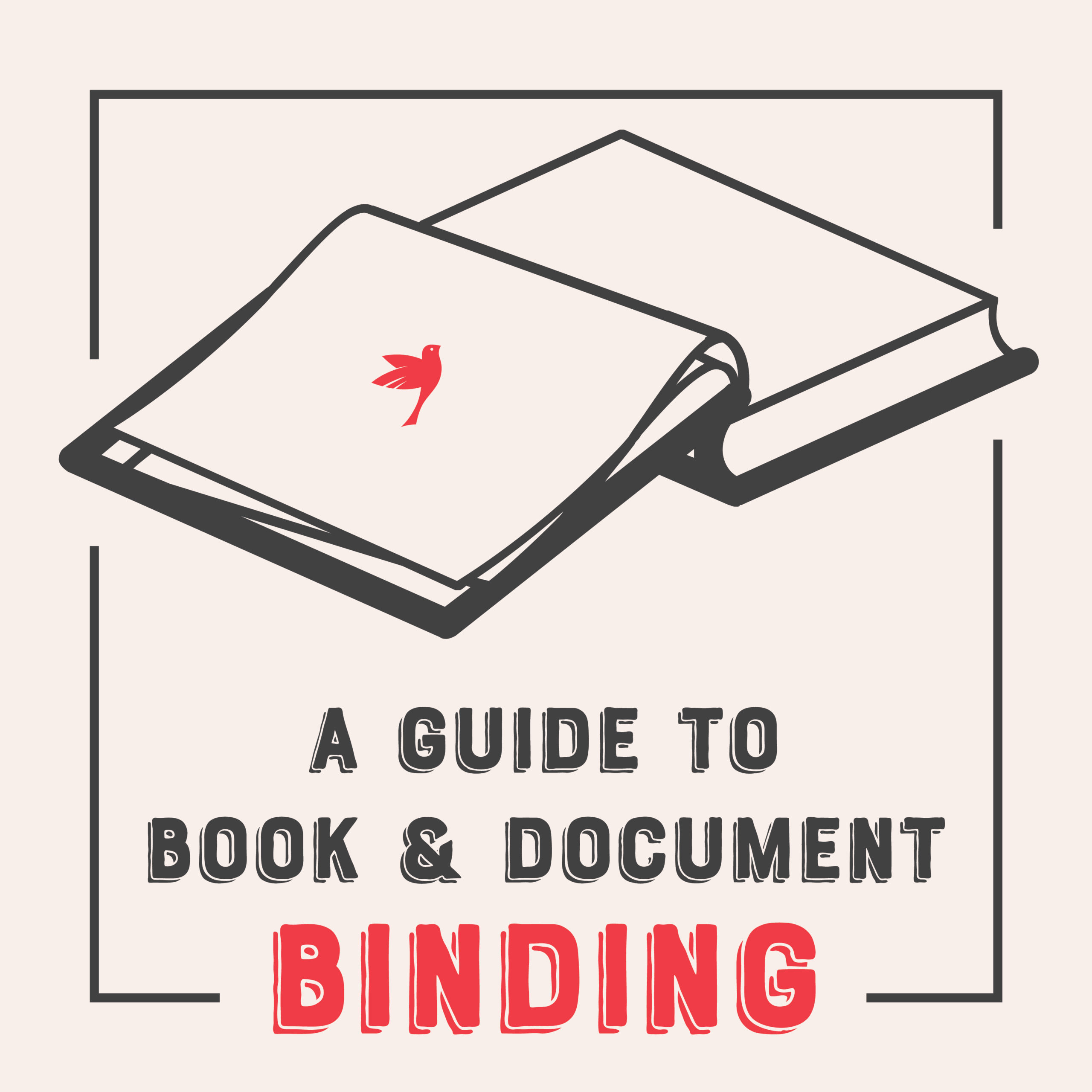We have to admit it. Our favourite projects often come in the multiple page variety.
Whether it’s graphic design for an annual report, research report, corporate profile, illustrated children’s book, photo book, recipe book… and the list goes on, the team at Martlette in Geelong, love to design books!
As part of the design process, it is always good to know what the printed copy will look like. We are not just talking about the paper quality, number of pages and colour palette. We also need to know how the book will be bound. There are so many options that we often find our clients daunted by the decision.
There are a few considerations to make when deciding on what binding style is right for your book, so here are a few tips to help you make the right decision.
Ask yourself… How will your book be used?
Think about the end user of your book. Will the reader need to lay the book flat when referencing its content? Does you book need artwork on the spine, so it can be viewed when on the shelf? Are you looking for a high standard or unique finish for a special presentation? By answering these questions, you will be able to determine the binding style that is perfect for your book and its reader. Your Annual Report designer will need to know the answers to these questions too – so chances are that you are half way there!
How many pages is it?
Depending on how many pages your book has, some binding methods will not be suitable. For example, staple bound books are best for books 70 pages or less. For books with more pages, you may need to consider an alternative binding style.
What is your budget?
With every project there is a budget and you will need to consider your options that will suit your budget next. Some binding methods require significant ‘hands-on’ work by your printer or binder and will therefore have a higher price tag. As an example, a saddle stitched book will usually cost less than a book that is perfectly bound due to the manual page assembly and binding process. Martlette Graphic Design and your printer will be able to guide you on what binding style will best suit your budget.
What is your timeframe?
Last, but definitely not the least important consideration is your timeframe. If your deadline is looming and you need your book in a hurry, you will need to choose a binding style that can be completed on time. For example, a hard cover or perfectly bound book require more ‘hands-on’ time dedicated to their completion and will need more lead time to meet your deadline. A saddle stitched book will take far less time to complete and may be a better option for a quick turn around.
Binding styles explained
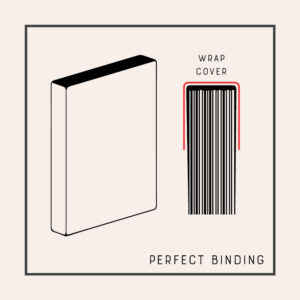
Perfect Binding
The most common type of binding you will find in book stores and for annual reports, pages are collated and bound by an adhesive bonding glue, then glued to a wrap around cover. The cover is scored on the front and back near the spin, so that the reader can open the book with ease. Perfect binding is perfect for premium annual reports, novels and children’s books and provides your book with a ‘spine’ edge, where the title of your book can also appear for ‘on-the-shelf’ visibility. Perfect binding is often less expensive when compared with hardcover binding.
- Ideal for 60-250 pages
- Give your printer/binder at least a week turn around
- Premium finish
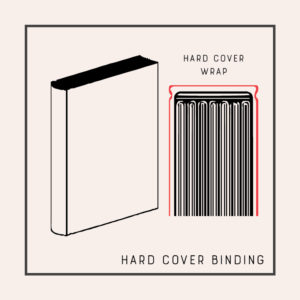
Hardcover Binding
Similar to the perfect binding method, a hardcover bound book is cased with a hard board cover with strong adhesive, making this binding option the perfect choice for durability and a premium feel. This option is great for large photo books, special presentations and any book where you want the quality to shine through.
- Ideal for 60-500 pages
- Give your printer/binder 1-2 weeks turn around time
- Premium and long lasting finish
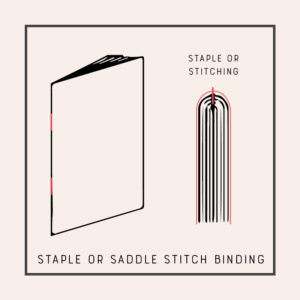
Staple or Saddle Stitch Binding
Pages are printed as double page spreads and folded at the centre. The spine is then stapled and folded to create the book. This method is also known commonly as “Saddle Stitching” where wire is used to bind the double spread pages at the spine. It is almost identical to Staple binding in its finished product, however the binding method is slightly different. By far the most popular and cost effective method of printing for Annual Reports, promotional booklets, information booklets, newsletters, handbooks and corporate profile booklets where the page number is 70 pages or less. The finished product provides durability and the ability for the book to lie flat for the ready.
- Ideal for 8-100 pages
- Give your printer 4-7 days turn around time
- Professional finish
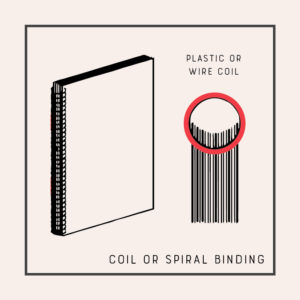
Coil or Spiral Binding
Using either a wire or plastic coil, pages of your book are threaded through punched holes and neatly trimmed at the end to prevent the pages from being detached from the rest of the book. A perfect choice for books that need to lay completely flat or for a 360 degree opening, such as recipe books, manuals, diaries and calendars.
- Ideal for 16-300 pages
- Quick turn around. Can sometimes be completed by your printer/binder within 2 days
- Great for ‘working documents’ that need to lay flat when opened 180 or 360 degrees
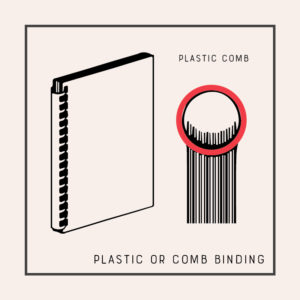
Plastic or Comb Binding
This is by far one of the most cost effective and fast options for binding a book that you only need a few of. The process of binding is completed by hand, so the cost may quickly increase if you need a large quantity. Most commonly used for research papers, reports and internal business documents. The plastic binding is often light weight and can be easily damaged with high usage.
- Ideal for 2-300 pages
- Can either be completed by your printer/binder, some office stationery stores or by yourself with the correct office binding equipment
- Working document standard – not long lasting.
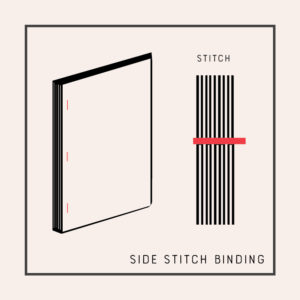
Side Stitch Binding
Most commonly used for note pads and tear off booklets, this binding process involves stacking all pages and inserting staples into the front of the book and through to the back. These types of books will not lie flat when opened but offers an inexpensive sturdy binding option.
- Ideal for 2-300 pages
- Give your printer/binder 4-5 days turn around time
- Notepad finish.
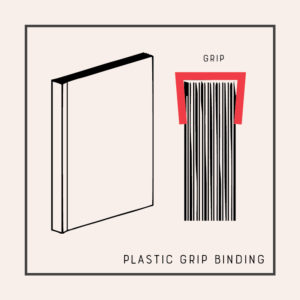
Plastic Grip Binding
This is an easy and inexpensive binding method that can be completed by you, that uses a pre-purchased molded plastic spine that you purchase from any good stationery store. The pages of your book are collated together and guided through one end of the plastic grip until it slides up and along the full length of the spine. Great for business documents, presentation of information or university assignments.
- Ideal for 2-300 pages
- Can either be completed by your printer/binder, some office stationery stores or by yourself with the correct grip binding spine.
- Working document standard – not long lasting.
Is there more to Binding?
Oh yes!! There certainly is! There is plenty more to learn in the world of book binding and there are some great places to learn about the old methods of binding books yourself, if you are keen to learn. However, if you are looking for options for your business books – Annual Report design, Corporate Profile, Handbooks, Manuals – Martlette is your local Graphic Designer in Geelong that can help you make the decision about the binding method best for you. Give us a call or send us a message if you have any questions. We would love to chat about your book design project!

